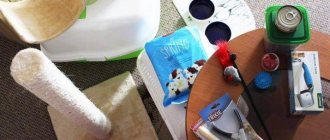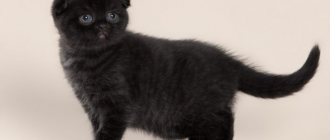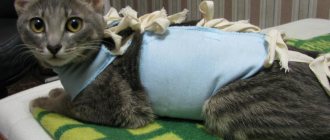Many owners believe that sterilization of Scottish Fold cats, given the undesirability of their sexual activity and uncontrolled reproduction, is too radical a measure. However, this assumption is not correct.
Manifestations of attraction cause discomfort to the animal, especially if he is locked in a house or apartment and cannot find a partner. However, many drugs that are used to suppress estrus in cats also have a number of side effects. Their systematic use harms the animal more than the sterilization procedure.
Features of sterilization of Scottish breeds
Sterilization and castration of representatives of Scottish breeds has some subtleties. It is advisable to carry out such procedures after the animal reaches puberty, but before the first mating. This will reduce the risk of adverse effects associated with performing the necessary manipulations and anesthesia. Representatives of Scottish cat breeds are distinguished by late maturation.
If sterilization was carried out after mating, even removal of the uterus and ovaries does not always eliminate the signs of heat. Removal of the ovaries and uterus in this case does not stop the activity of the pituitary gland, so sexual desire can persist due to a compensatory increase in the production of sex hormones at the physiologically programmed time of estrus.
In this case, sterilization surgery allows you to avoid the appearance of offspring, but will not save you from the obsessive behavior of the animal. The situation is similar for cats of Scottish breeds. Males should be castrated before their first mating.
General information about the procedure
Castration of a cat is an operation to remove the testes and suppress the sexual function of the pet.
There are several methods for carrying out the procedure:
- Surgical (or classical). Most cat owners in Russia resort to this method of castration.
- Chemical. A chemical composition is injected into the testes. It destroys the glands, and they are replaced by connective tissue elements. Veterinarians consider this method simple and cheap. However, it has not yet found application in Russia.
- Medical sterilization is the implantation of implants under the skin of a cat. They secrete a drug that completely suppresses the cat’s sexual function. This type of castration is not cheap, but it is absolutely safe for your pet’s health.
- Radiation castration. The cat's testes are placed under a source of gamma radiation to suppress sexual function. The method is reliable, safe for the health of the animal and simple in technique. To carry it out, you will need special equipment, which is not available in all clinics, so the cost of the procedure will be high. Complications are extremely rare. In addition, the cat does not need to undergo either general anesthesia or local anesthesia.
Pros of the operation
Veterinarians believe that this procedure is necessary for animals that will not be used in breeding activities. The owner must study all the advantages of the operation and possible consequences and make an independent decision.
Benefits of the procedure:
- increasing the life expectancy of a pet;
- reducing the risk of developing oncology and diseases of the genitourinary system;
- the pet’s character becomes more balanced;
- getting rid of obsessive and loud meowing;
- cats no longer mark territory;
- suppressing the cat's desire to run away from home in search of a partner.
Negative consequences
During or after the procedure, your pet may experience various complications:
- sudden weight gain due to a slowdown in metabolism in the body;
- development of urolithiasis;
- suture infection;
- pain at the incision site;
- bleeding from the suture;
- disruption of the gastrointestinal tract.
Castration can be fatal, so the operation is prohibited for cats with the following diseases:
- renal failure;
- urolithiasis disease;
- cardiopulmonary failure;
- liver diseases.
Types of sterilization
There are several options for operations used to sterilize Scottish cats. In addition, several procedures have been developed to make castrating cats as painless as possible for him. Nowadays, both surgical and chemical methods are actively used in veterinary practice.
Classical sterilization is quite traumatic for a cat. It is performed through a wide incision along the linea alba or along the side. The second option is less traumatic, but often does not allow sufficient access to completely remove the reproductive organs.
Tubal occlusion procedures are often used to prevent pregnancy in cats. This manipulation involves a laparoscopic intervention in which ligation of the fallopian tubes is performed. Since the organs of the reproductive system are not removed in this case, the animal tolerates such intervention more easily.
Laparoscopic sterilization is often performed. This procedure involves gaining access to the organs through a small incision not exceeding 2 cm. After this, a special disinfected hook is inserted into the wound, with the help of which the ovary and the ligament supporting it are hooked. After this, a ligature is applied and the ovary is removed. The entire uterus can be removed in the same way.
Endoscopic sterilization is an expensive and effective method of surgery. During such a surgical intervention, all manipulations are carried out with special instruments, under the control of an endoscope equipped with a light source and a camera. Access is obtained through small punctures in the abdominal cavity.
In addition, the procedure of oophorectomy is often used. It involves removing not only the ovaries, but also the uterus. Such a procedure can be carried out both according to indications and as planned. Since a long incision is made to perform the manipulations, the cat requires long-term rehabilitation after an ovariectomy.
If radical sterilization is undesirable, a chemical method can be used. This type of sterilization involves sewing a special implant under the skin, thanks to which a drug that suppresses the animal’s sexual activity enters the animal’s bloodstream. The effect of such an implant is limited to 3 years.
Early sterilization
To prevent the appearance of sexual desire, the animal is often neutered early; in this case, the kitten may develop health problems in the future. If the cat was spayed between 6 and 8 months of age, in most cases there will be no postoperative problems, since the organs are already well developed during this period. When carrying out early sterilization, faster healing of wound surfaces is observed with minimal risk of complications.
Cats that survive early neutering develop a more powerful musculoskeletal system. At the same time, in the future, Scottish cats who have undergone the procedure often experience hormonal imbalances. Most often, after early castration, animals experience inappropriate behavioral reactions due to increased activity of the pituitary gland.
Early sterilization can also have delayed consequences. Often, cats that have undergone a similar procedure before puberty develop endocrine diseases at 5-7 years of age. In addition, kidney function may deteriorate. If the cat could not cope with the disease and, unfortunately, died, funeral services for animals in Moscow will come to your aid.
Postoperative care rules
Care of the wound surface in cats is not required. However, you need to ensure that your pet does not lick the wound area. If sterilization in cats was carried out laparotomically, then the sutures need to be treated from the second day. For this, antiseptic solutions and ointments are used to improve regeneration.
The main negative consequence for a pet after castration is obesity. Therefore, sooner or later the question arises of what to feed a neutered Scottish cat:
- If the pet was on a natural diet, then it is necessary to review the diet. First of all, you need to determine your daily calorie intake. After castration, it is recommended to slightly reduce the portion. If previously the norm was calculated using the formula 80 kcal per 1 kg, then after castration the caloric intake decreases: 60–70 kcal per 1 kg. In addition, add more fiber to your diet in the form of vegetables, as well as boiled meat. Also eliminate milk from your diet.
- If the cat has been eating dry food, it is better to change it to a special product for neutered animals. Such foods have a balanced composition and are also aimed at preventing urolithiasis. For example, Vet Care Nutrition from Royal Canin (premium food) or Proplan food labeled Sterilized.
Sterilization of adult cats
Despite the fact that it is advisable to sterilize Scottish cats at a young age, mature animals are also seen by a veterinarian for this purpose. Adult cats are more difficult to tolerate such interventions, since any wound surfaces heal more slowly in them.
At the same time, carrying out manipulation allows not only to correct the behavior of the animal, but also to reduce the risk of developing dangerous complications, incl. cystic formations and some types of cancerous tumors. In addition, for older cats, labor is associated with a high risk of complications. In this case, timely castration can prevent death.
Care
Do not be alarmed when, after the procedure, the veterinarian gives you a half-asleep animal in an almost unconscious state. The pet can remain in this form for up to a day - this is the effect of anesthesia. It is better to leave a sleeping cat on her favorite bed, but always on the floor. Gradually, the cat will begin to come to its senses, at first its coordination of movements will be impaired, and if it wakes up on a hill, for example, on a window, it can fall to the floor and get injured. By the way, it is not recommended to feed animals before surgery.
A mandatory rule in the postoperative period is rest and warmth. Under no circumstances should you leave a newly sterilized cat on the balcony or terrace - this can even lead to death. Make sure that the animal does not lick the wound area. If sterilization was carried out with an intradermal suture, then the cat does not need a blanket. If it was an external suture, then a special blanket is put on the animal, and after about 10 days the owner will have to visit the veterinarian again to have the sutures removed.
After surgery, every owner is required to change the pet’s diet. For example, for cats it is recommended to reduce the daily portion. The menu should be supplemented with fiber and boiled meat. If the owner prefers to feed his pet with special food, then it should be premium and super-premium products. It is recommended to consult a veterinarian regarding nutritional issues for a specific animal. The doctor will not only recommend the products of the most suitable manufacturer, but will also individually calculate the daily food intake.
See below for information on cat sterilization.
Cons of the operation
Any surgical intervention in animals carries some risks. The most common postoperative complications include:
- peritonitis;
- suppuration of wounds;
- sepsis;
- deterioration of the cardiovascular system;
- pulmonary edema, etc.
These violations can cause death. To prevent the occurrence of postoperative complications, it is necessary to conduct a comprehensive examination of the animal in advance and assess its general health. In addition, approximately 5% of Scottish cats experience a temporary increase in sexual desire after complete removal of the uterus and ovaries. Increased anxiety of the animal can persist for 6 months.
Conclusion
You need to make a decision about whether your pet will bear offspring or not even before the first heat occurs. But if you want to get offspring from a cat, and nothing more, weigh the pros and cons.
Sterilization can certainly be carried out at any time, especially for medical reasons, but you need to understand that in some situations this approach can lead to serious complications. How ready are you for this?
The questions of whether it is possible to sterilize a cat and what consequences there may be are of concern to many pet lovers, and therefore quite often arise in their minds. Either this arises from personal worries about the animal, or he is illiterate in this matter. But still, there is certain unrest and there is no escape from it.
The culture of sterilizing an animal is very common in Western countries and has not long been considered something out of the ordinary. This procedure is not scary and inhumane, but quite the contrary, it is the only measure to prevent the risk of unplanned offspring in an animal, as well as to preserve its health and especially the health of its reproductive function.
Consequences
The consequences of a cat sterilization operation depend on how many months the procedure was performed. If the manipulation was performed before the onset of puberty, when the internal organs of the animal are not yet fully formed, the risk of further inflammatory diseases of the urinary tract and the formation of stones is increased.
It has been noted that Scottish Fold cats require a special diet. If fed improperly, animals quickly gain weight. Obesity in Scottish cats often causes problems with the cardiovascular and respiratory systems. These pathologies can negatively affect the life expectancy of the animal.
All information posted on the site is provided in accordance with the User Agreement and is not a direct instruction to action. We strongly recommend that before using any product, you must obtain a face-to-face consultation at an accredited veterinary clinic.
What will change after castration
The recovery process after surgery lasts about 1-2 weeks, depending on how the castration was performed. Since a cat’s metabolism slows down after castration, and this can lead to excess weight, it is necessary to switch it to dietary food. Veterinarians recommend playing with your pet more often and making him run more. This will help keep you in good shape.
Whether a Scot will mark after castration depends on the age at which the operation was performed. If at that time the cat was already sexually mature and managed to develop the habit of leaving marks, then he will continue to do this instinctively. However, your pet's behavior will change for the better and he will not suffer from hormonal surges.











